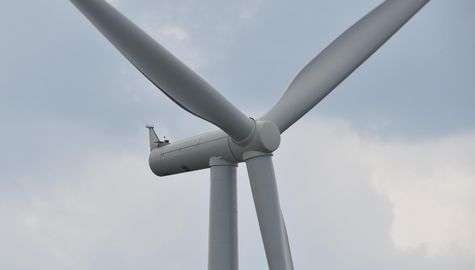By Jennifer McDermott, Associated Press
PROVIDENCE, R.I. (AP) — The nation’s first offshore wind farm has experienced safety and welding problems, and regulators are closely monitoring construction, according to the regulatory agency that issued a permit for the work.
Deepwater Wind is building a five-turbine wind farm off Block Island and began construction in July. Inspection reports about the initial weeks of construction identified “numerous” health and safety issues.
The safety problems have been addressed with the builder, said Grover Fugate, executive director of the Rhode Island Coastal Resources Management Council. He said he’s working with Deepwater Wind to ensure the problem with the welding process is only a paperwork issue.
“It’s a difficult environment to work in so there are opportunities for problems to creep up,” Fugate said Thursday. “We want to make sure we minimize any opportunities for them to become serious.”
Deepwater Wind said it intends for the project to meet the highest safety and construction standards.
“We remain confident in the project’s safe and steady progress,” Deepwater Wind CEO Jeffrey Grybowski said in a statement.
The company declined to answer questions.
The wind farm is expected to power 17,000 homes by the end of 2016.
The federal government has now issued nine leases for offshore wind projects in federal waters. The government is poised to auction one lease, or possibly two new leases, off New Jersey in November and is assessing potential sites off multiple states. The Block Island wind farm is in state waters.
An inspector’s report cites near misses with dropped objects, personnel working under suspended loads, the use of older cranes poorly suited to the offshore environment and the repeated failure of rigging equipment. A construction barge dented one of the foundations in the water in July, then two cranes collided during night work, Fugate said. The foundation was repaired.
Safety representatives are now on each barge and Deepwater Wind adopted several other safety recommendations, including conducting a “safety stand-down” to review practices, he added. Another lift boat was added after a review of crane capabilities.
A second report, submitted last week, said there were no weld maps that could be traced if a problem arose, and it identified other issues with the welding process. Procedures and drawings were not available on board, and voltmeters were broken, it said.
The welds checked out perfectly during inspections, Fugate said.
The CRMC is a regulatory agency and the landowner for the project, so it issued both a permit and a lease.
ABS Group was hired to make sure components are built to the design standards that regulators approved and proper protocols are followed. The group wrote the two reports on the progress, which were reported on by ecoRI News.
Fugate, who speaks with inspectors daily, said he has the power to stop all work at the site immediately, something he hasn’t had to do.
Other inspectors are making sure the project isn’t harming the environment, and they haven’t reported any issues, Fugate said.
“We’ve got everything in place to monitor it,” he said.
Deepwater Wind said it has installed the five steel foundations on the sea floor and workers are driving piles and installing platforms.
Work will stop over the winter and resume in the spring with the installation of the undersea cables, followed by the turbines themselves.














